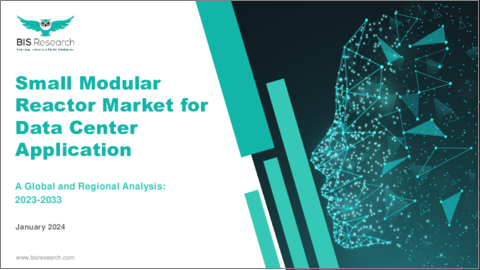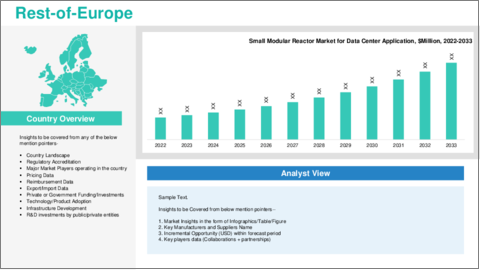|
|
市場調査レポート
商品コード
1375831
データセンター向け小型モジュール炉市場:製品別、国別分析:分析と予測(2023年~2028年)Small Modular Reactor Market for Data Center Application: Focus on Product, and Country-Wise Analysis - Analysis and Forecast, 2023-2028 |
||||||
カスタマイズ可能
適宜更新あり
|
|||||||
| データセンター向け小型モジュール炉市場:製品別、国別分析:分析と予測(2023年~2028年) |
|
出版日: 2023年11月08日
発行: BIS Research
ページ情報: 英文
納期: 7~10営業日
|
- 全表示
- 概要
- 目次
急成長するデータセンター業界は、電力需要の増大、信頼性への懸念、持続可能性の目標に直面しています。
原子力技術のコンパクトなモジュール型であるSMR(小型モジュール炉)は、こうした課題に対応する潜在的なエネルギー源として登場しました。
データセンター向け小型モジュール炉市場の成長は、データセンターのエネルギー需要の増加、信頼性が高く弾力性のある電源の必要性、二酸化炭素排出に対する意識の高まりに起因しています。データセンター用途でのSMRの利用には、いくつかの明確な利点と機会があります。SMRは信頼性の高い電源を提供し、グリッド故障別データセンターのダウンタイムリスクを最小限に抑えます。モジュール式であるため拡張性があり、データセンターは必要に応じてエネルギー容量を拡張できます。
データセンター用途の世界のSMR市場は、データセンター業界のエネルギー需要の増大と持続可能性の目標に対処するための説得力のあるソリューションです。信頼性、持続可能性、エネルギー安全保障などの利点は明らかですが、規制、コスト、廃棄物管理に関する課題を過小評価すべきではありません。
データセンターにおけるSMRの可能性を評価するためには、バランスの取れたアプローチが重要です。市場が発展し続ける中、利害関係者は、関連する課題に対処しながらSMR技術の可能性を最大限に活用するために、安全性、規制、持続可能性の基準について協力しなければなりません。データセンターへのSMRの統合が成功すれば、この業界に革命をもたらし、デジタル時代の弾力的で持続可能な安全なエネルギー供給を保証する可能性があります。
当レポートでは、世界のデータセンター向け小型モジュール炉市場について調査し、市場の概要とともに、製品別、用途別、地域別の動向、市場規模、成長動向、成長促進要因などを中心に解説しています。
目次
第1章 市場
- 業界の見通し
- ビジネスダイナミクス
- 世界のデータセンター用途向けの小型モジュール炉市場における主要な新興企業
- COVID-19によるデータセンター向け小型モジュール炉市場への影響
第2章 製品
- 世界のデータセンター向け小型モジュール炉市場(炉タイプ別)
- 世界のデータセンター向け小型モジュール炉市場の需要分析(炉タイプ別)
- 特許分析
- 各種発電方式の比較分析
第3章 地域
- 北米
- 欧州
- 英国
- 中国
- アジア太平洋
- その他の地域
第4章 市場-競合ベンチマーキングと企業プロファイル
- 競合ベンチマーキング
- 市場シェア分析
- 企業プロファイル
- ARC CLEAN ENERGY
- Framatome
- GE Hitachi Nuclear Energy
- General Atomics
- Holtec International
- Lead Cold
- NuScale
- Ontario Power generation
- Rolls-Royce PLC
- Seaborg technologies
- SNC-Lavalin Group
- Terrestrial Energy Inc.
- Toshiba Energy Systems
- U-Battery
- Ultra Safe Nuclear
- Westinghouse Electric company
- X Energy LLC
- その他の主要参入企業
第5章 調査手法
The burgeoning data center industry is confronted with escalating power demands, reliability concerns, and sustainability targets. SMRs (Small Modular Reactors), a compact and modular form of nuclear technology, have emerged as a potential energy source to meet these challenges.
Market Overview
This report provides an overview of the global SMR market for data center applications, emphasizing market size, growth trends, and the driving forces behind its expansion.
Market Size and Growth
- Growth in this market can be attributed to the increasing energy demands of data centers, the need for reliable and resilient power sources, and the growing awareness of carbon emissions.
Opportunities and Advantages
The utilization of SMRs for data center applications offers several distinct advantages and opportunities.
Reliability and Resilience
- SMRs provide a highly reliable power source, minimizing the risk of data center downtime due to grid failures.
- Their modular nature enables scalability, ensuring that data centers can expand their energy capacity as needed.
Sustainability and Emission Reduction
- SMRs offer a lower carbon footprint compared to conventional fossil fuel-based power sources.
- Their compact design allows for reduced land usage and potentially lower environmental impact.
Energy Security
- SMRs can enhance energy security by reducing dependency on external power grids, making data centers more self-sufficient.
Challenges and Considerations
While the potential benefits of SMRs for data center applications are compelling, several challenges and considerations merit attention.
Regulatory and Safety Concerns
- Regulatory approval and public acceptance for nuclear technologies can be a complex and time-consuming process.
- Safety and security measures are paramount and require ongoing attention to mitigate risks.
Cost and Implementation
- Initial investment costs for SMRs can be substantial, requiring a clear business case and long-term planning.
- The integration of nuclear technology within data centers necessitates thorough engineering and site suitability assessments.
Waste Management
- Proper waste management, including the handling and disposal of nuclear waste, is a critical aspect of SMR operations.
The global SMR market for data center applications represents a compelling solution to address the increasing energy demands and sustainability goals of the data center industry. While the advantages, such as reliability, sustainability, and energy security, are evident, challenges related to regulations, costs, and waste management should not be underestimated.
This report underscores the importance of a balanced approach to evaluating the potential of SMRs in data centers. As the market continues to evolve, stakeholders must collaborate on safety, regulatory, and sustainability standards to harness the full potential of SMR technology while addressing its associated challenges. The successful integration of SMRs into data centers has the potential to revolutionize the industry, ensuring a resilient, sustainable, and secure energy supply for the digital age.
Table of Contents
1. Markets
- 1.1. Industry Outlook
- 1.1.1. Market Definition
- 1.1.2. Trends Current and Future
- 1.1.3. Ecosystem / Ongoing Programs
- 1.1.3.1. Associations and Consortiums
- 1.1.3.2. Government Programs and Initiatives Landscape
- 1.2. Business Dynamics
- 1.2.1. Business Drivers
- 1.2.2. Business Challenges
- 1.2.3. Business Strategies
- 1.2.3.1. Product Developments
- 1.2.3.2. Market Developments
- 1.2.4. Business Opportunities
- 1.2.5. Corporate Strategies
- 1.2.5.1. Mergers & Acquisitions
- 1.2.5.2. Partnerships, Collaborations & Joint Ventures
- 1.3. Key Start-Ups in the Global Small Modular Reactor Market for Data Center Application
- 1.3.1. Key Start-ups in the Ecosystem
- 1.3.2. Funding Analysis
- 1.3.2.1. Major Investors
- 1.3.2.2. Top Innovations
- 1.4. COVID-19 Impact on Small Modular Reactor Market for Data Center Application
2. Products
- 2.1. Global Small Modular Reactor Market for Data Center Application (by Reactor Type)
- 2.1.1. Water Cooled Reactor
- 2.1.1.1. Land-Based
- 2.1.1.2. Marina-Based
- 2.1.2. High Temperature Gas Cooled Reactor
- 2.1.3. Fast Neutron Spectrum Reactor
- 2.1.4. Molten Salt Reactor
- 2.1.5. Micro-Sized
- 2.1.1. Water Cooled Reactor
- 2.2. Demand Analysis of Global Small Modular Reactor Market for Data Center Application (by Reactor Type)
- 2.3. Patent Analysis
- 2.3.1. Patents Analysis (by Organization)
- 2.3.2. Patent Analysis (by Status)
- 2.3.3. Patents Analysis (by Patent Office)
- 2.4. Comparative Analysis on Various Power Generation Methods
- 2.4.1. Cost Comparison
- 2.4.2. Current Level of Deployment
- 2.4.3. Supply Chain Network for Each Power Source
3. Region
- 3.1. North America
- 3.1.1. Markets
- 3.1.1.1. Key Solution Providers in North America
- 3.1.1.2. Business Challenges
- 3.1.1.3. Business Drivers
- 3.1.2. Products
- 3.1.2.1. North America Small Modular Reactor Market for Data Center Application (By Product)
- 3.1.3. North America: Country Level Analysis
- 3.1.3.1. United States (U.S.)
- 3.1.3.1.1. Markets
- 3.1.3.1.1.1. Buyer Attributes
- 3.1.3.1.1.2. Key Solution Providers in the U.S.
- 3.1.3.1.1.3. Business Challenges
- 3.1.3.1.1.4. Business Drivers
- 3.1.3.1.2. Products
- 3.1.3.1.2.1. U.S. Small Modular Reactor Market for Data Center Application (By Product)
- 3.1.3.1.1. Markets
- 3.1.3.1. United States (U.S.)
- 3.1.1. Markets
Note: Similar Details will be covered for other countries as well
- 3.1.3.2. Canada
- 3.2. Europe
- 3.2.1. Markets
- 3.2.1.1. Key Solution Providers in Europe
- 3.2.1.2. Business Challenges
- 3.2.1.3. Business Drivers
- 3.2.2. Products
- 3.2.2.1. Europe Small Modular Reactor Market for Data Center Application (by Products)
- 3.2.3. Europe: Country Level Analysis
- 3.2.3.1. Germany
- 3.2.3.1.1. Markets
- 3.2.3.1.1.1. Buyer Attributes
- 3.2.3.1.1.2. Key Solution Providers in Germany
- 3.2.3.1.1.3. Business Challenges
- 3.2.3.1.1.4. Business Drivers
- 3.2.3.1.2. Products
- 3.2.3.1.2.1. Germany Small Modular Reactor Market for Data Center Application (By Product)
- 3.2.3.1.1. Markets
- 3.2.3.2. France
- 3.2.3.3. Russia
- 3.2.3.4. Rest-of-Europe
- 3.2.3.1. Germany
- 3.2.1. Markets
- 3.3. United Kingdom (U.K.)
- 3.3.1. Markets
- 3.3.1.1. Buyer Attributes
- 3.3.1.2. Key Solution Providers in the U.K.
- 3.3.1.3. Business Challenges
- 3.3.1.4. Business Drivers
- 3.3.2. Products
- 3.3.2.1. U.K. Small Modular Reactor Market for Data Center Application (by Product)
- 3.3.1. Markets
- 3.4. China
- 3.4.1. Markets
- 3.4.1.1. Buyer Attributes
- 3.4.1.2. Key Solution Providers in China
- 3.4.1.3. Business Challenges
- 3.4.1.4. Business Drivers
- 3.4.2. Products
- 3.4.2.1. China Small Modular Reactor Market for Data Center Application (by Product)
- 3.4.1. Markets
- 3.5. Asia-Pacific
- 3.5.1. Markets
- 3.5.1.1. Key Solution Providers in Asia-Pacific
- 3.5.1.2. Business Challenges
- 3.5.1.3. Business Drivers
- 3.5.2. Products
- 3.5.2.1. Asia-Pacific Small Modular Reactor Market for Data Center Application (by Product)
- 3.5.3. Asia Pacific: Country Level Analysis
- 3.5.3.1. Japan
- 3.5.3.1.1. Markets
- 3.5.3.1.1.1. Buyer Attributes
- 3.5.3.1.1.2. Key Solution Providers in Japan
- 3.5.3.1.1.3. Business Challenges
- 3.5.3.1.1.4. Business Drivers
- 3.5.3.1.2. Products
- 3.5.3.1.2.1. Japan Small Modular Reactor Market for Data Center Application (By Product)
- 3.5.3.1.1. Markets
- 3.5.3.1. Japan
- 3.5.1. Markets
Note: Similar Details will be covered for other countries as well
- 3.5.3.2. India
- 3.5.3.3. South Korea
- 3.5.3.4. Rest-of-Asia-Pacific
- 3.6. Rest-of-the-World
- 3.6.1. Markets
- 3.6.1.1. Key Solution Providers in Rest-of-the-World
- 3.6.1.2. Business Challenges
- 3.6.1.3. Business Drivers
- 3.6.2. Products
- 3.6.2.1. Rest-of-the-World Small Modular Reactor Market for Data Center Application (by Product)
- 3.6.3. Rest-of-the-World: Country Level Analysis
- 3.6.3.1. Middle East and Africa
- 3.6.3.1.1. Markets
- 3.6.3.1.1.1. Buyer Attributes
- 3.6.3.1.1.2. Key Solution Providers in Middle East and Africa
- 3.6.3.1.1.3. Business Challenges
- 3.6.3.1.1.4. Business Drivers
- 3.6.3.1.2. Products
- 3.6.3.1.2.1. Middle East and Africa Small Modular Reactor Market for Data Center Application (By Product)
- 3.6.3.1.1. Markets
- 3.6.3.1. Middle East and Africa
- 3.6.1. Markets
Note: Similar Details will be covered for other countries as well
- 3.6.3.2. Brazil
- 3.6.3.3. Argentina
4. MARKETS -Competitive Benchmarking & Company Profiles
- 4.1. Competitive Benchmarking
- 4.2. Market Share Analysis
- 4.3. Company Profiles
- 4.3.1. ARC CLEAN ENERGY
- 4.3.1.1. Company Overview
- 4.3.1.1.1. Role of the Company in the Global Small Modular Reactor Market for Data Center Application
- 4.3.1.1.2. Product Portfolio
- 4.3.1.1.3. Key Target Segment
- 4.3.1.2. Business Strategies
- 4.3.1.2.1. Product Developments
- 4.3.1.2.2. Market Developments
- 4.3.1.3. Corporate Strategies
- 4.3.1.3.1. Mergers & Acquisitions
- 4.3.1.3.2. Partnerships, Collaborations & Joint Ventures
- 4.3.1.1. Company Overview
- 4.3.1. ARC CLEAN ENERGY
(Note: similar information will be provided for the following companies)
- 4.3.2. Framatome
- 4.3.3. GE Hitachi Nuclear Energy
- 4.3.4. General Atomics
- 4.3.5. Holtec International
- 4.3.6. Lead Cold
- 4.3.7. NuScale
- 4.3.8. Ontario Power generation
- 4.3.9. Rolls-Royce PLC
- 4.3.10. Seaborg technologies
- 4.3.11. SNC-Lavalin Group
- 4.3.12. Terrestrial Energy Inc.
- 4.3.13. Toshiba Energy Systems
- 4.3.14. U-Battery
- 4.3.15. Ultra Safe Nuclear
- 4.3.16. Westinghouse Electric company
- 4.3.17. X Energy LLC
- 4.3.18. Other Key Players
5. Research Methodology
- 5.1. Data Sources
- 5.1.1. Primary Data Sources
- 5.1.2. Secondary Data Sources
- 5.2. Data Triangulation
- 5.3. Market Estimation & Forecast
- 5.3.1. Factors for Data Prediction and Modelling






